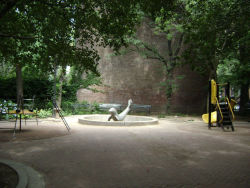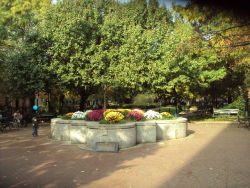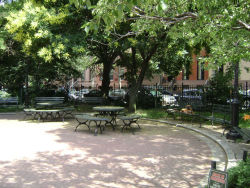Cobble Hill Park
Cobble Hill Park
The calm setting of present-day Cobble Hill Park belies an area with a history of contention. Its namesake, the surrounding neighborhood of Cobble Hill, was first settled in the mid-17th century by Dutch farmers when Governor Peter Stuyvesant permitted farming north of Red Hook. At this time, the area was known as Punkiesberg. In 1776, during the Battle of Long Island, the Continental Army called the area "Cobble Hill" after a similar hill they had recently fortified during the Siege of Boston. The redoubt at Cobble Hill was actually named "Smith's Barbette" after the army engineer, Captain William Smith, who supervised its construction. The hill was part of a line of defense running from Gowanus Bay to Wallabout Bay, site of the Brooklyn Navy Yard . The area was again fortified during the War of 1812 and temporarily renamed "Fort Swift," but the name Cobble Hill remained associated with the area.
A century and a half later, the trapezoidal area bounded by Verandah Place and Clinton and Henry Streets again became an area of dispute. Three buildings stood on the site-the Weber and Whitten mansions and an abandoned Unitarian Church, the Church of the Turtle. During the late 1940's the Bohack Corporation purchased the property and demolished the two mansions. In the early 1960s, the same corporation proposed the construction of a supermarket on this site, but the Cobble Hill community united in opposition to the project. At this time, the neighborhood association of Cobble Hill stated that they were in need of a park. In 1962 the property was sold to private builders who razed the church and moved forward with plans to construct a six-story 128-family brick apartment building. News of a budding neighborhood park movement prompted the builders to move up their construction schedule to July or August of 1962.
From late April to July 1962, the Cobble Hill Association, West Brooklyn Independent Democrats, and residents of Cobble Hill mobilized to make the property a park. They collected 1200 signatures and successfully petitioned the City Planning Commission, Bureau of Budget, Parks, and the Mayor's Office. The plot officially became City property on March 7, 1963. Plans were soon underway to construct a park that would both provide an area for passive recreation and protect a heavily urbanized area from further development. Cobble Hill Park was formally dedicated on July 14, 1965. Its prominent features at the time included new trees and shrubs, game tables, concrete walls, and a sand pit area.
Cobble Hill Park was reconstructed by Parks in 1989. The new design won the 1988 Annual Award for Excellence in Design from the Art Commission and the Parks Council's first Philip Winslow Award for Public Projects in 1990. The steel-panel fencing and concrete slabs of the 1960s park were replaced by a design more in harmony with the surrounding Greek Revival architecture. The formal, geometric pattern of present-day Cobble Hill Park utilizes 19th-century period materials such as blue stone and cast iron as well as granite entrance columns and herringbone-patterned brick walkways.
Check out your park's Vital Signs
Clean & Safe
Green & Resilient
Empowered & Engaged Users
Share your feedback or learn more about how this park is part of a
Vital Park System



